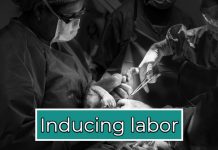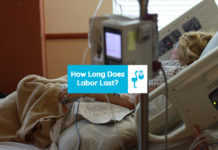Labor pain is ranked high on the pain ranking list when compared to other painful life experiences1.
The very thought of feeling this unimaginable and indescribable pain along with a vaginal tear seems the scariest part of pregnancy. Some women might still be unaware that labor and delivery can last up to 24 hours.

Superficially, precipitous labor may seem like a blessing than a complication. But the fact is is that despite being 24 or 12 hours long, normal labor allows you the necessary time, needed to cope with each step.
About 2% of women who have rapid labor and delivery don’t get the time to adjust to the changes happening. The rapid wild contractions cannot be controlled, and often the delivery occurs in stray places like elevators or bathroom floors.
What is precipitous labor?
It is the process of going into active labor, birth, and placenta in less than 5 hours. One may not be able to make it to the hospital, and thus, birth can occur outside the hospital.
The three stages include active labor, birth and placenta delivery.
How fast is precipitate delivery? It can be as quick as 3 hours about 1/4th the time of the still short labor duration of 12 hours.
Some women have phases of contractions that occur at different times during a period of three days or even five days. Compared to normal labor, it is as fast as almost immediate delivery of the baby after entering active labor (It is during the active labor that most women feel an urge to push).
Rapid labor can be as quick as 3 hours about 1/4th the time of the still short duration labor of 12 hours.
Reasons and Risk Factors for Precipitous Labor
Statistical data shows that women going to give birth to their second or third child are at higher risk of precipitate labor.
What are the risks of having rapid labor?
This can happen because of a wider vagina or smaller baby size. Other risk factors include incidents of precipitate labor in the family.
There is a genetic correlation to the chance of having precipitate labor.
What are the chances of having precipitous labor?
Women who have had previous deliveries naturally have a shorter labor. They are at higher risk. There can be other reasons like consumption of drugs such as cocaine during pregnancy.
What are the causes of precipitous labor?
Delivery from a precipitous labor is called precipitate delivery. 10 Factors that affect chances are:
1) Smaller baby well placed in the vagina
During labor, the push is not solely by the mother’s hormonal changes. The movements of the fetus have a role to play while giving birth. A smaller size of baby and correct position make labor pain easier. As the baby is little, the vagina doesn’t require too much of oxytocin as a smaller expansion will serve the purpose.
2) Wide vagina or birth canal
Some women have a large pelvis because of body shape. Others may have a wider birth canal naturally. As the passage for the delivery of the baby is wide, it automatically reduces the effort for birth. Even the not so violent contractions can push the baby out.
3) Perfect alignment or position of the canal
The vagina is not a straight pipe up. It is instead slightly tilted. In cases where women have an extremely titled vagina, they have vaginismus. Moreover, a straight vagina is not favorable in accordance with gravitational dynamics.
4) Autism in baby
Out of the many genetic defects, autism is the one that parents can quickly come to know during gestation. Nonetheless, if they desire to have the child or did not opt for the test, the risk of precipitous labour is one of the consequences. However, it doesn’t mean that your baby has or even may have Autism.
5) Genetic predisposition for a precipitous labor
In some families, women tend to undergo precipitous labor due to genes running in the lineage. Thus, if someone’s sister or any related woman had such an experience, she must mentally prepare herself. In maximum cases, during precipitate labor, the pregnant woman is unable to make to the hospital. Blood, placenta, and pain cannot be managed at the time without any preparation. If aware of any factors or risks, one must take precautions.
6) Efficient uterine contractions
Some women who have labor for 24 hours do not shout and whale, as shown in the movies. Active labor and uterine contractions are related but not the same. When you reach the last week of the third trimester, pregnancy water breaks. After this, the contractions of the vagina set it. The vaginal contractions come and then subside, and every next contraction is more powerful. Some women might take longer to have rhythmic contractions with enough vigor to be able to deliver the baby. In case a woman has efficient contractions close to the starting of labor she can have precipitate labor.
7) An overdose of Pitocin or Syntocinon drug
During pregnancy, the level of oxytocin increases from first to last trimester. This hormone is responsible for labor, breastfeeding, and bonding between mother and newborn. Unlike the release of oxytocin from the hypothalamus, part of the brain, an external administration can never be regulated precisely. Oxytocin injected intravenously leads to stronger contractions. This puts the woman at a higher risk of precipitate labor.
8) Second or third delivery
After the first pregnancy, the vagina has experienced expanding and contractions. Those women who have multiple pregnancies, after going through the process deliver faster.
Can I have precipitate labor again if I had previous precipitous labor? Precipitate delivery in the last pregnancy is another sign that you are most likely to have it again. The duration of labor reduces with consequent pregnancy.
9) Consumption of drugs such as cocaine during pregnancy
Cocaine is a stimulant drug that affects physiological processes, enhancing them. It changes the central nervous system and causes an increase in the pace of processes. Oxytocin also releases from the brain and so rises rapidly.
10) Induced labor
Women who don’t get a positive Fetal Non Stress Test cannot wait until natural labor onset. There are many ways, such as using prostaglandins or oxytocin drugs or artificial rupture of membrane. In most cases after labor is induced there is no way to stop it, and as it gets rapid, the risk of precipitous labour increases. Induced labor using prostaglandins most probably end as precipitate labor or even cesarean.
11) Artificial Rupture of membrane
During artificial rupture of the membrane, a small scraping tool breaks the pregnant water after placing the head towards the vagina. Once the baby’s head comes near the opening, the contractions are rapid. Can you induce labor to prevent another sudden rapid labour? Ideally, you must not induce labor unless there is no alternative. This procedure increases the chance of having precipitate labor.
12) Hypertension during pregnancy
High blood pressure can cause more rapid contractions. Women with raised blood pressure during pregnancy are asked to be cautious.
13) Fertility treatments
During fertility treatments, external administration of hormones can also lead to precipitous labour.
Signs of Rapid Labor
Some women might want to estimate the time of their labor. Are there any signs of precipitate labor?
In most cases, the incidence is so immediate that there is no time to notice the signs.
As the delivery due date is near, pregnant water leaking starts in some pregnant women. The breaking of water early is a sign that things could go faster than expected.
You may feel that the baby will just come out even when the labor is not at its peak. Sweating and other usual labor symptoms will be exaggerated.
- Early pregnant water leaking
- Rapid continuous contractions
- Feeling heavy load on the lower end
- Rising heartbeat and other distress indicators
- An absence of recovery phase between contractions
Consequences of Precipitous Labor
Even if it sounds better to have done with a thing that takes 12 hours within the shortest span, there is worse to it.
Can precipitous labor lead to complications during and after birth? Yes, this is why induced labor is discouraged because it mostly ends up in cesarean or precipitous labor.
Even the administration of oxytocin is not done unless essential as very long labor is equally damaging.
- Mother is in acute distress: The pain of vaginal tearing, contractions of the uterus similar to period pain hundred times the usual is not less than a trauma. All this happening at a breakneck pace naturally will cause distress to the mother. The process, even in normal condition leads to pain. Will fast labor affect the mother emotionally? During precipitous labor, there is a lack of support as everything happens too quickly. While handling it all alone or with minimal assistance, the mother suffers from unbearable pain. Analgesics are restricted during labor and not given during precipitate labor.
- Postpartum depression: Reasons for a mother to suffer from postpartum depression are emotional distress or hormonal imbalance or both. After undergoing the quick, violent labor the mother finds it harder to adapt to the new life. She has lacerations and deep tears such as a third-degree vaginal tear. As she is not exposed to the long-term effects of oxytocin, she will have a harder time adjusting to the fall of hormones.
- Placenta retention: Some parts of the placenta may still be inside the womb after parturition. It happens because the labor contractions last for a shorter span.
- Bleeding and hemorrhage: Due to the violent contractions, the bleeding can get heavier. The perineal tear is wider and allows more blood to flow out.
- Wider perineal tearing, cervical and vaginal laceration: A laceration is like tearing of skin and underlying tissues. The birth process is so vigorous that it leads to deep and rugged tearing of inner organs too.
- Atony of the uterus: After labor is over the uterus opening returns to its normal form. However, it is possible that after the labor, the opening of the uterus may not return to average size. This condition in which the uterus doesn’t contract after the delivery of the baby is called uterine atony. It can lead to postpartum hemorrhage.
Can rapid labor harm baby? How does precipitous labor affect your baby?
1) Delivery without sterilization
There is no time to prepare for delivery when sudden labor starts. Such delivery outside the sterilized environment can cause infections. Temperate fluctuations can cause the baby to catch a cold as they cannot bear the changes. You must give baby body heat to prevent such infections. However, the mother is in trauma and pain.
2) Aspiration
During rapid and uncontrolled labor the amniotic fluid can get inside the baby. The baby can poop inside which calls for an immediate C section. Aspiration is taking in the surrounding fluids that can cause suffocation.
3) Slower bonding between mother and fetus
Oxytocin is the hormone responsible for labor, bonding, and maternal recognition, and breastfeeding. Women who undergo artificial labor, take longer to bond with their baby. During such an episode, a mother may have seen the worst situations of delivering on the bathroom floor and facing death. After such trauma and the lack of natural exposure to oxytocin and having high levels of adrenaline, the bonding will take longer.
4) Newborn undergoes trauma
The violent contractions are the baby’s first encounter with life outside the womb. The bones still undeveloped bend in any direction. Injury from fall or mismanagement can also lead to severe issues.
5) Hypoxia
During labor the fetus is under pressure and oxygen is a must. Hypoxia, limited oxygen supply, is common during rapid labour. When the oxygen supply is reduced, there are chances that the baby gets unconscious. Fast labor can push umbilical cord out first, prolapse, in which oxygen supply cuts off.
6) Cerebral hemorrhage of newborn
The scalp of the baby is not bony, and so the skin can tear. Bleeding from the head of the baby is fatal. Head suffers too many jerks making the baby go in a state of trauma.
How can you prepare for rapid labor?
There is nothing really that you can do because precipitous labor is unexpected and can happen anywhere. You may contact your doula about the risks of having such labor. One can keep a kit ready with some soft mattresses, cotton, sweet candy, plastic bags, towel, maternity pads, etc. and take it along whenever you go out.






![Why Do You Fast Before Cesarean? [Fasting Before C-Section Facts] Why do you fast before Caesarean?](https://www.pregnanteve.com/wp-content/uploads/2019/03/fast_before_cesarean-218x150.jpg)


